I have so often eaten Italian food prepared by Italians (both in restaurants and at home) and have studied so many Italian cookery books, websites, blogs, and forums, that I am confident when I am cooking Italian food and know when it tastes like it is supposed to taste, and when it does not. Although I have been preparing Thai food for some years now (click here for an overview of all Thai dishes on my blog) and like it a lot, I had never been to Thailand and so I am not as confident about Thai cooking as I am about Italian.
As I am in Thailand for the first time right now, I thought it would be a good opportunity to gain some confidence. First and foremost by eating a lot of Thai food in restaurants here, as well as street food. I have eaten in Thai restaurants in the Netherlands and in other countries, but was not impressed (and noticed they used factory-produced curry paste and the like). It was clear to me that the flavors were ‘westernized’ to appeal to the local public. After a couple of days, I do get the impression that even here in Thailand it is difficult to find restaurants (or street food stalls) that serve authentic flavors, as even here the food is adapted to tourists (more sweet, less spicy, even avoiding cilantro). I am OK with less spicy than ‘Thai spicy’ because I am not used to that (both your palate and your digestion need to be trained to be able to tolerate such spicy food), but a lot of the food I had here was less spicy than what I prepare myself at home.

Another way of getting to know Thai cuisine better is of course to take a Thai cooking lesson by a local. There are a lot of Thai cooking classes here in Chiang Mai, but they mostly aim at absolute beginners who hardly know how to prepare food from their own country. And they start by explaining the difference between dry and fresh chillies, or between ginger and galangal. So I would probably not learn anything from those, and decided straight away that a class in a group was not going to work for me. With some googling I discovered a site called Traveling Spoon, a platform to book private cooking classes with home cooks around the world. Through them I booked a private cooking experience and lunch with Pea (dinner is also available). I had ‘warned’ her that I was already quite experienced, so she adapted our session to be more advanced. But I also specifically asked her to prepare some dishes together that I had prepared before, to explore any differences together.
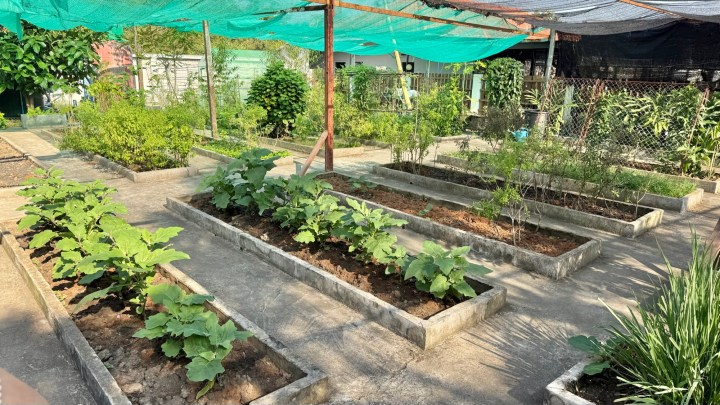
We started with a tour of the garden, where Pea grows her own vegetables and herbs. There had been a flood recently, so everything had to be replanted.
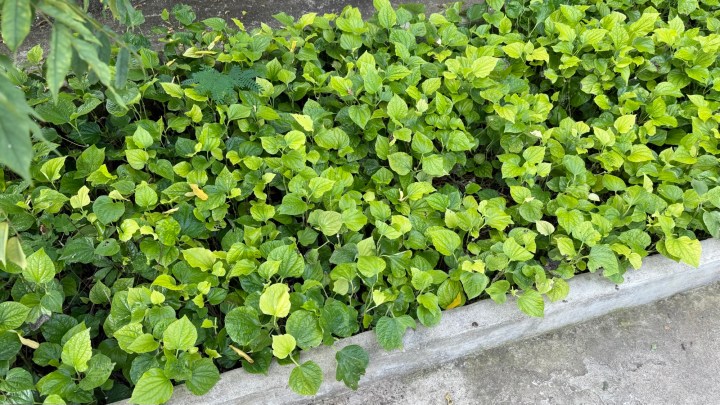
Betel leaves (for Miang kham, see below).
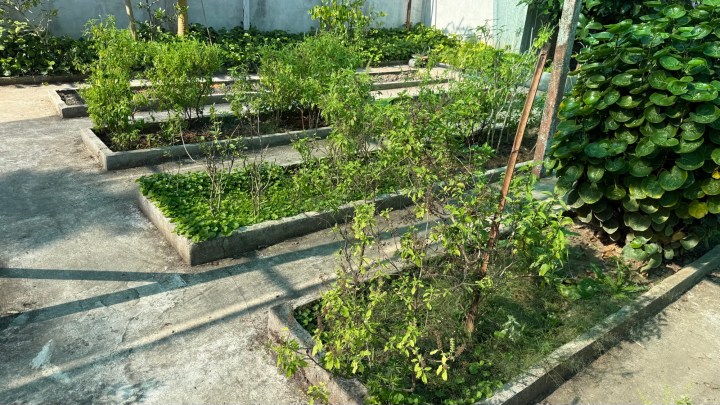
Sweet thai basil (horapa) and holy thai basil (kaprao).

A type of green beans that are very tender and you can eat raw as well as steamed.
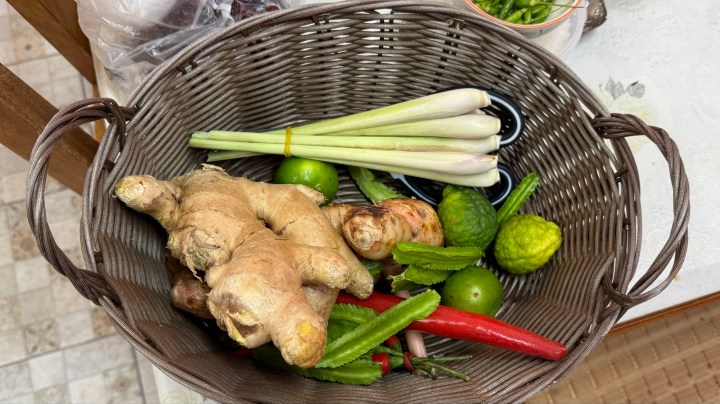
You can see the green beans better at the front of this photo.
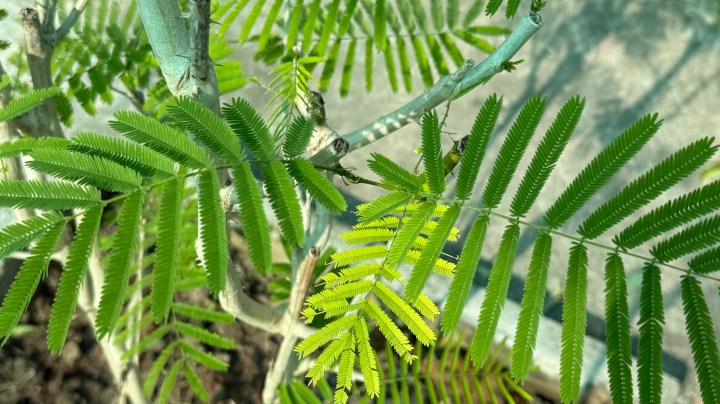
A mild tasting herb used for omelette.
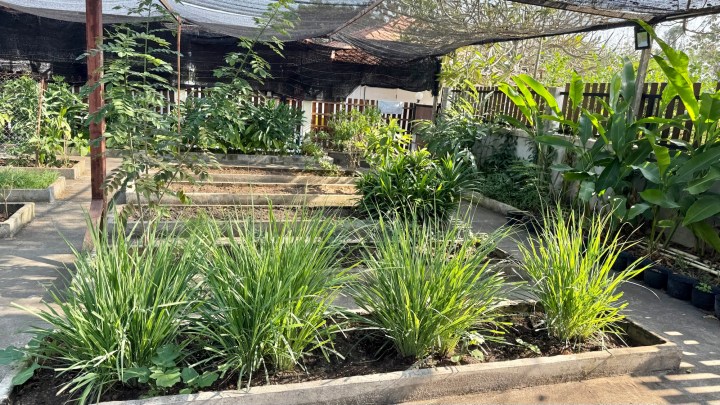
Lemongrass.

Most cuisines have a ‘holy trinity’. For Thai cooking it is chillies, garlic, and shallots. (For Italian it is onion, carrot, and celery.) The flavor profile of most dishes starts with the trinity and builds from there. Pea explained that home versions of Thai dishes often have less ingredients than restaurant versions, because people use what they have. And so ingredients like shrimp paste or coriander root can be omitted or substituted (e.g. more fish sauce if you don’t have shrimp paste). (Pea mentioned that she used coriander root mostly as a barbecue marinade for meat, pounded together with garlic and peppercorns.) We were going to make some ‘home cooking’ dishes from the Northern Thai cuisine.
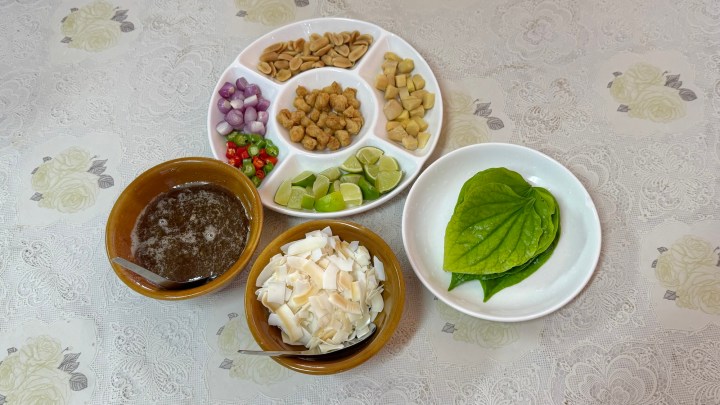
As a welcome Pea had prepared Miang kham for me. This is a snack of fresh betel leaves that you stuff with small pieces of fresh ginger, shallot, lime (you are supposed to eat the lime with the skin), roasted peanut, dried shrimp or crispy fried tofu, dried coconut, and chili, and a sauce. The sauce is made by blending 2 cups of lemon grass, 2 cups of palm sugar, 1/2 cup of shallot, 1/2 cup of finger ginger, and 1 teaspoon of salt until smooth, and then simmering in a saucepan until light brown (but served at room temperature).
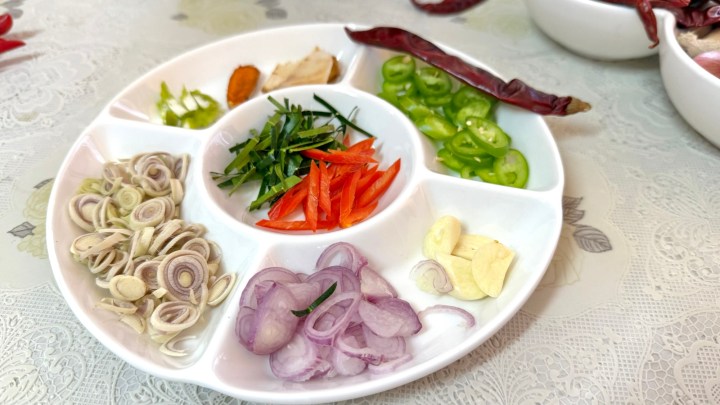
We started by making a Panang Curry, a dish that I have made before. The most important ingredients for red or green curry are shown in the photo: the holy trinity of chillies (fresh green or dried red), garlic, and shallots; salt, lemongrass, kaffir lime zest, galangal, and turmeric root (the latter to improve the color) for the curry paste, kaffir lime leaves and non-spicy chilies as garnish, and fish sauce and palm sugar for seasoning. To make it a Panang Curry, we make a red curry paste and add ground cumin and ground coriander. Compared to the version I prepared before, the main difference is less ingredients; missing are peanuts, white pepper, coriander root, and shrimp paste.
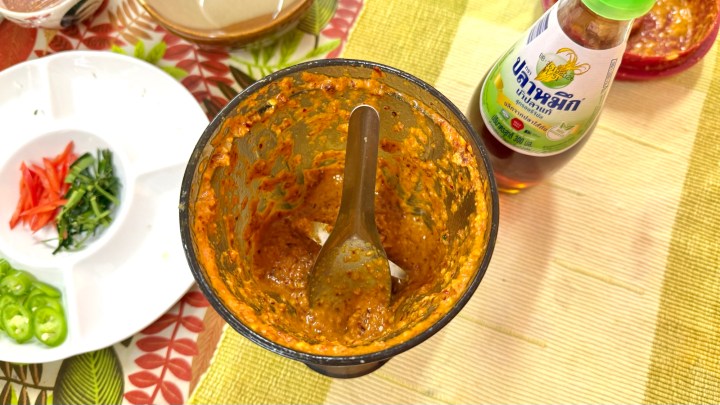
We used a blender to make the curry paste, although the amount was a bit small for the blender to work well (but I don’t like using mortar and pestle). Pea eyeballed all of the amounts rather than using measurements, and encouraged me to taste the curry paste also before cooking it and adjusting it to my personal flavor. Thai food is about a balance between the four S: Spicy, Sour, Sweet, and Salty. She also said that everyone has a personal preference as to what is the preferred balance between those four. She agreed with my balance of sour, sweet, and salty, but would make it more spicy (as could be expected as I am not used to as much chili as Thai).
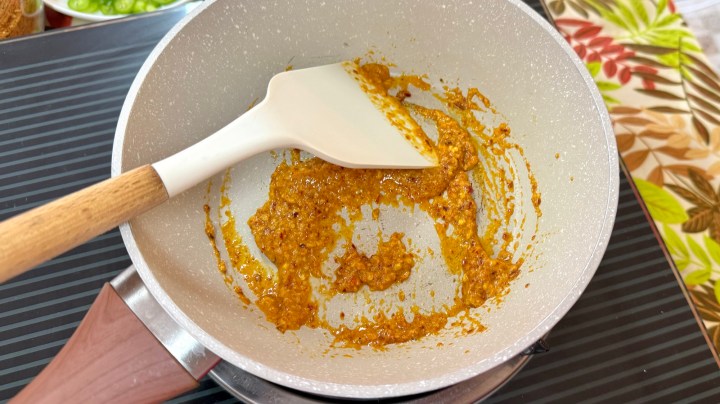
We used some cooking oil or coconut oil to get the blender going to make the paste. This meant that instead of using the coconut cream that floats on top of coconut milk, we could fry the curry paste in a dry pan (as it already contains oil). This makes the curry more creamy, because in the final dish we will have both the oil and the coconut cream. Pea said the color of the curry paste would have been more red if we had soaked the dried red chillies for a longer time.
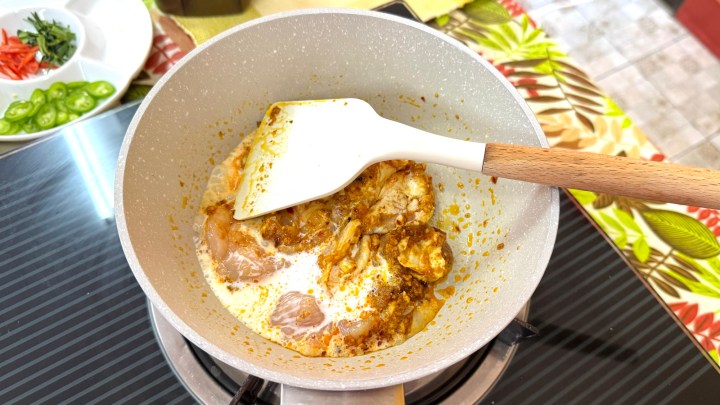
The chicken was added, along with a bit of coconut milk. Pea added the coconut milk gradually. It was chicken breast, so it cooked very quickly. We tasted it again and added some more cumin and coriander and seasoned the curry with palm sugar and fish sauce. (Lime juice is not used in Panang curry.)
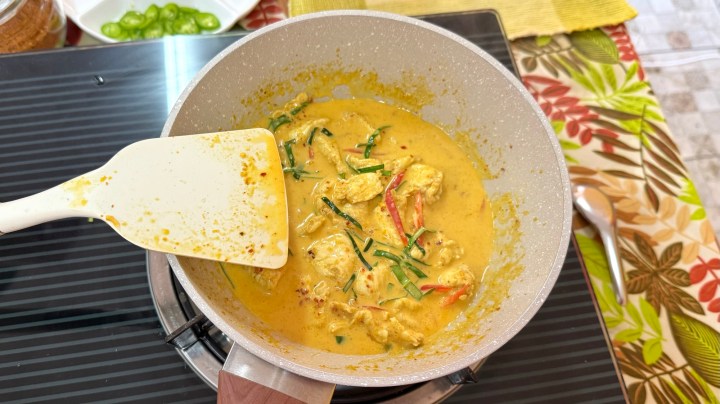
When the chicken was cooked, we added julienned red chili (non spicy) and kaffir lime leaf, stirred, and then turned off the heat.

The chicken Panang curry was done and I enjoyed it with some rice.
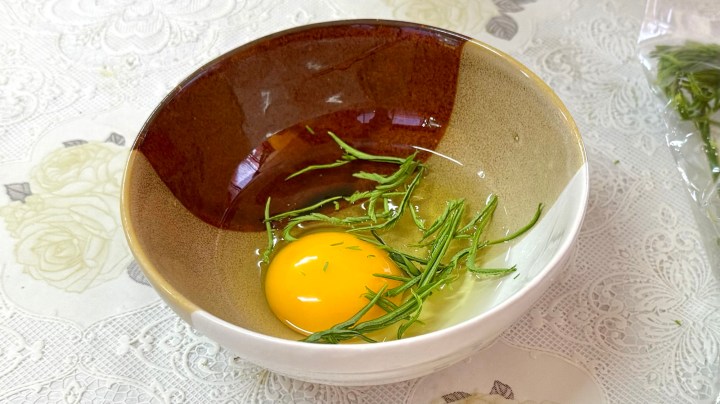
In the meantime, Pea was making an omelette by mixing an egg with the green feathery herbs and a splash of fish sauce.
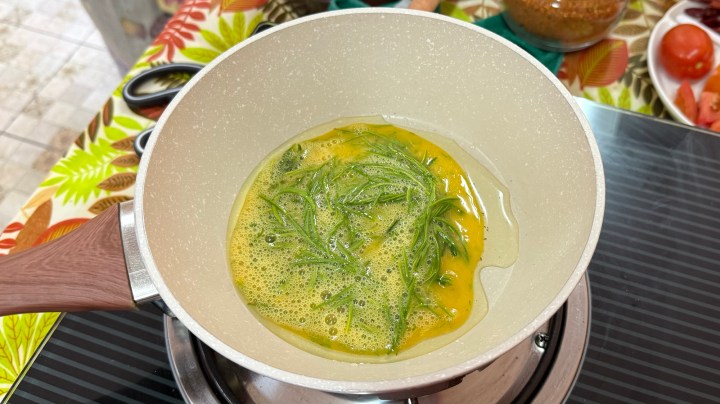
The omelette was fried on both sides…
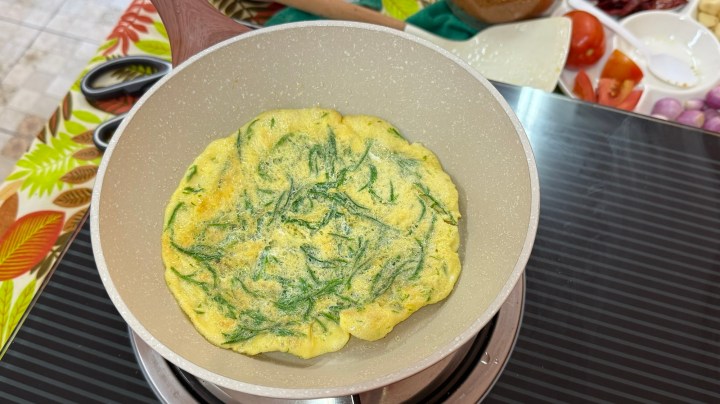
…until slightly golden. The omelette was one of the foods to have with the Nam prik kapi dip that we were going to make next.
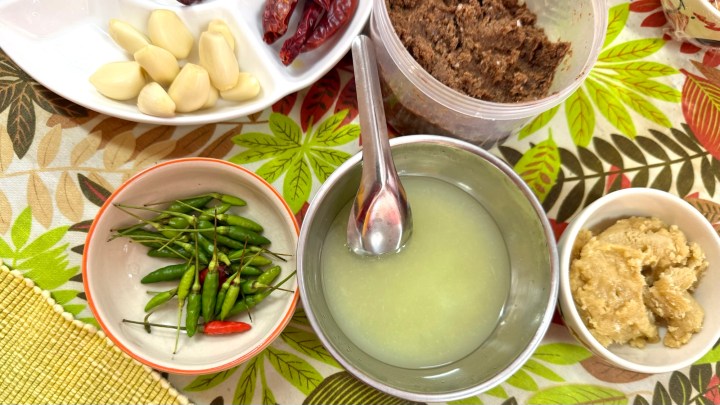
Nam prik kapi is a dip of fermented shrimp paste, sweet shrimp paste, fresh chilies, lime juice, palm sugar, fish sauce, and garlic.

We started by pounding garlic with chilies and palm sugar.

Then two types of shrimp paste were added.

This is the sweet shrimp paste, sweetened with palm sugar.

The dip was finished with fish sauce and lime juice, to make it more liquid as well as for the flavor. After adding those, it was necessary to taste to make sure the balance was still right. I added some more palm sugar and then it was perfect. Pea added some chilies as garnish for those who would like more spiciness.
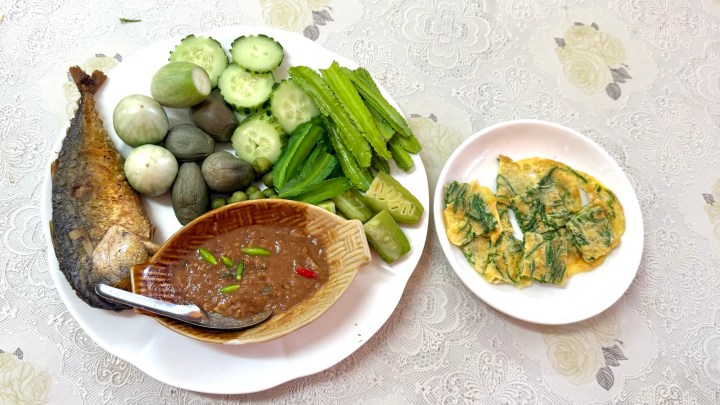
The nam prik kapi was served with fried fish, the omelette, steamed eggplant, beans, and bitter melon, and raw cucumber, eggplant, and beans.
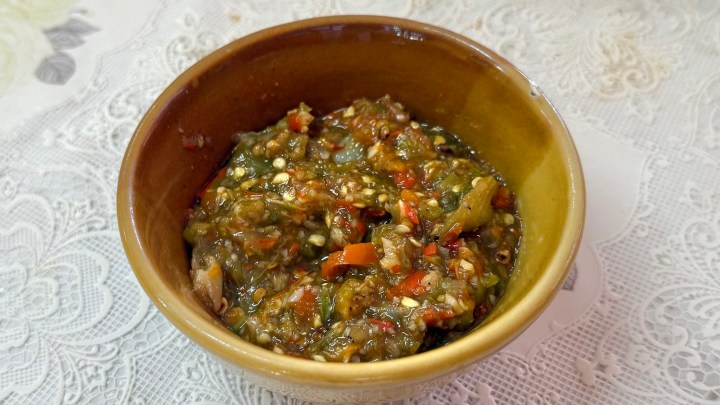
Pea also let me taste a dip that was made for the dinner they were hosting in the evening, which contained eggplant, tomato, shallots, fresh chili, garlic, and fermented fish sauce. Despite the fermented fish and chili, the flavor of this dip reminded me somewhat of ratatouille.
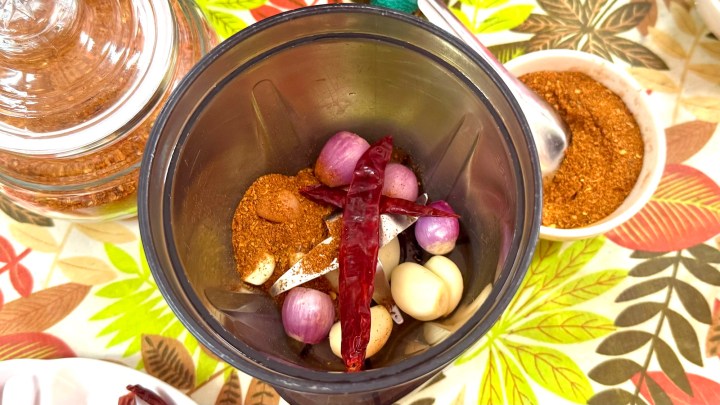
The next dish we were making was Gaeng Som, a sour fish soup that I had made before with shrimp. We started by blending the usual trinity of chili (in part as ground chili), shallots, and garlic.
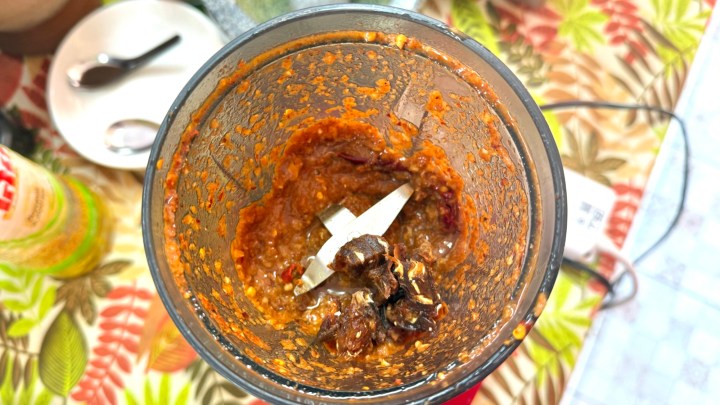
Then water and tamarind were added and blended.
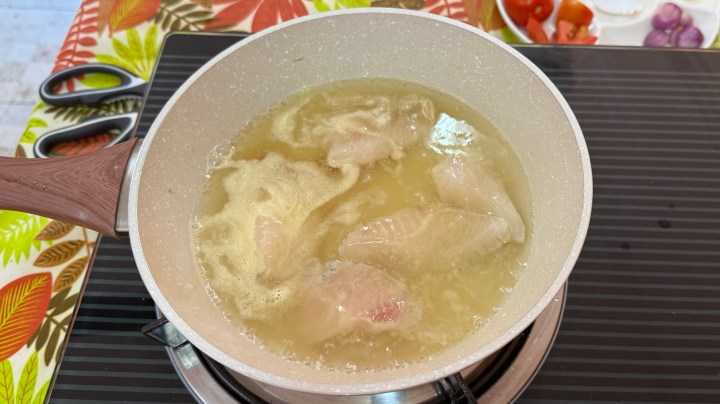
The fish (tilapia) was poached in water with salt and a bouillon cube. (When I made Kaeng Som myself, I used fish heads and bones to make the stock.)
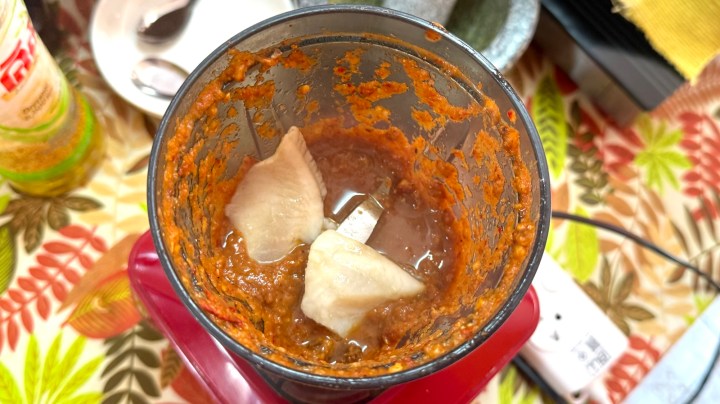
A bit of the cooked fish was added to the blender to thicken the soup and to give it a more fishy flavor.

Then the contents of the blender were added to the soup…
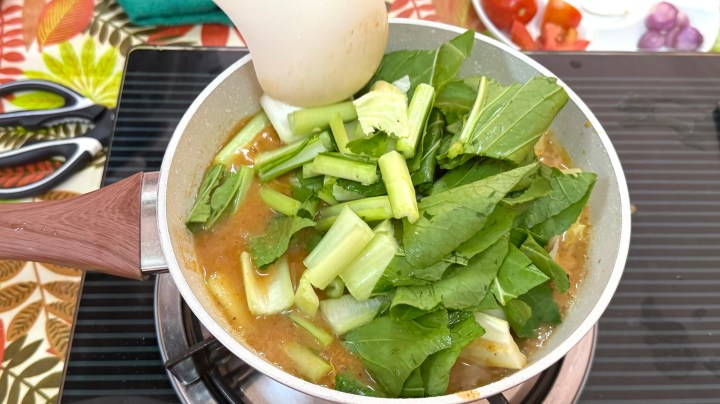
…followed by the vegetables: bok choy and a stalky vegetable.
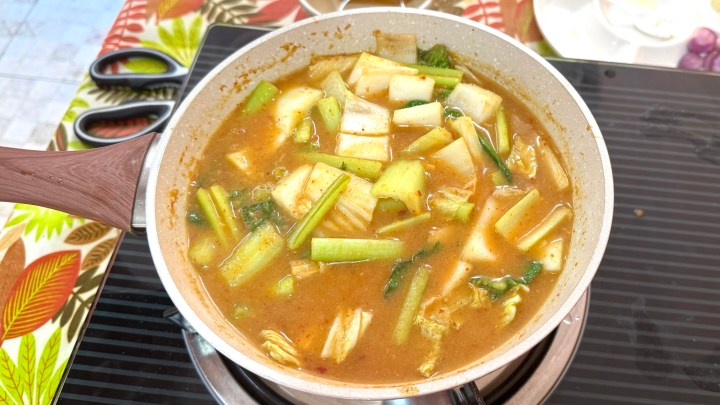
The vegetables were boiled only briefly, to keep them crunchy. (Note that I would usually separate the green leaves from the bok choy and add them later, and allow the fish to poach in the hot soup without boiling it.) Because the vegetables release water, the soup had to be tasted to adjust the seasoning. It needed some more fish sauce.
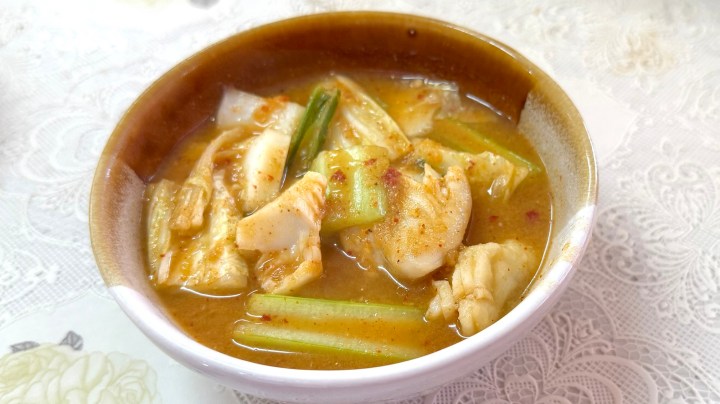
The resulting Kaeng Som was very nice. Pea let me also taste some pork soup that was being made for that evening, which was very nice as well.

The final thing we made was Nam prik ong, a pork and tomato chili dip. You can guess that we started again with the holy trinity of (dried red) chili, garlic, and shallots.
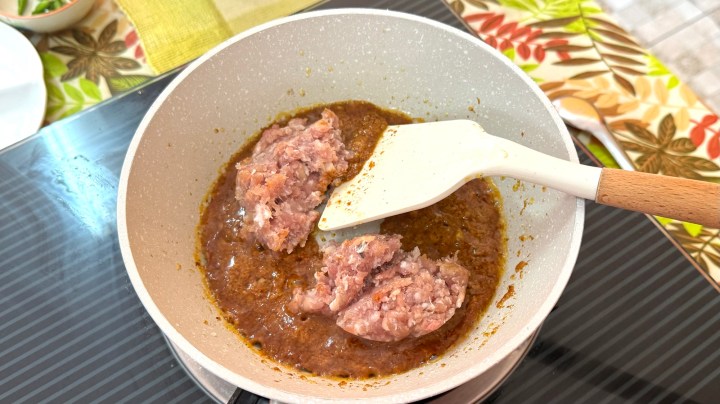
This was fried in a bit of oil, and then ground pork was added.

When the pork was almost cooked through and broken up, diced tomato was added. It is important to use sour tomato for this, to get enough of a sour note in the dip.
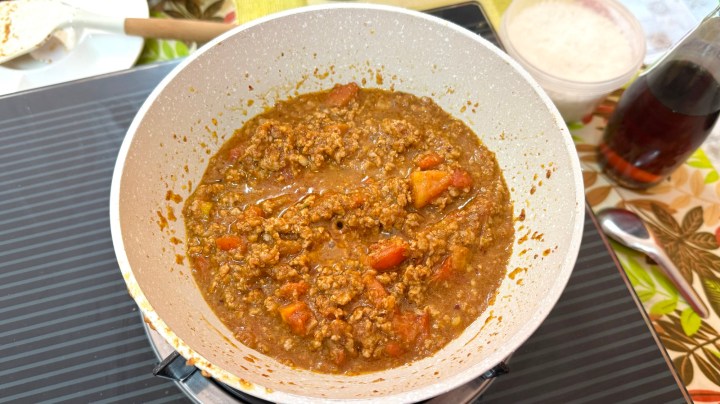
The tomatoes are cooked only briefly, and then the dip is seasoned with fish sauce. It is interesting to note that, unlike in most Italian recipes, the tomatoes are not peeled and seeded. But otherwise this is almost like a watery version of a (southern) Italian pork ragù (in south Italy chili is used in almost everything and they would use onions instead of shallots). The flavor is not watery, but the texture is definitely more watery than Italian ragù.
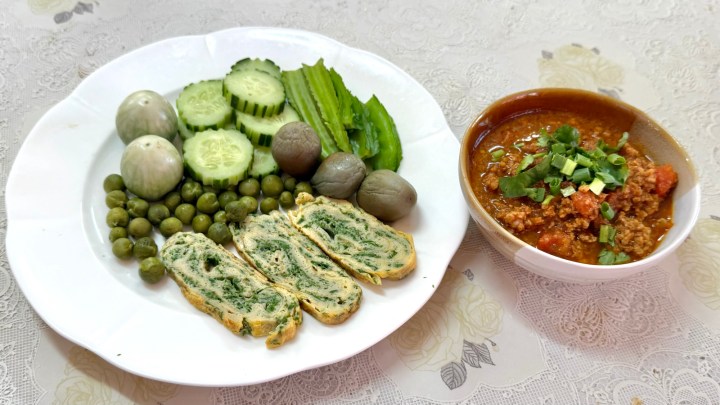
The Nam prik ong was served as a dip for vegetables and some more omelette.
This cooking class has reached the goal I had with it, to become more confident in my Thai cooking. I learned to be more relaxed about it, got to know some nice dips, and improved by pestle and mortar technique.


Consider doing a streetfood tour with a local guide.
LikeLiked by 2 people
Well done Stefan, am jealous – I love Thai food (well, such as I have known it which is probably not very ‘authentic’, except for a couple of dishes that a friend of mine once prepared for us and she had lived in Thailand. Sei proprio bravo, complimenti! Happy new year!
LikeLiked by 1 person
Thank you, Jo. Happy new year to you, too. If you come to Amsterdam, I’ll cook Thai for you if you like.
LikeLike
A lovely morning surprise to discover you and your new blog here. Have just subscribed and am looking forwards to learning and sharing 🙂 !
LikeLiked by 1 person
Thanks, I did see some of those tours at the same streetfood stalls where we went.
LikeLike
thanks for this good inforation
LikeLiked by 1 person
Beautiful garden! Your dishes look wonderful and tasty. I took a cooking class in Bangkok and although I didn’t make anything out of the ordinary, it was fun having access to fresh galangal and kaffir lime leaves. I have to order mine from Amazon!
LikeLiked by 2 people
Sounds like a lovely experience!
LikeLiked by 1 person
Am thrilled to bits at the moment! Both for your experiences and my luck in being able to read them. I enjoyed my first so-called ‘Royal Thai’ weekend-long cookery lessons in Bangkok way, way back in my 20s and 30s . . . I remember cutting pretty vegetable and fruit rosettes more than any practical cooking help I could really use back home! Oh, and I soon learned to ask for a ‘medium’ curry in the restaurants instead of the braggadocio of asking ‘hot’! Meanwhile your lesson to us and the fab photos are hugely appreciated . . . and, may we have more, if time allows 🙂 ?
LikeLiked by 1 person
Thanks Eha. This was only a brief visit to Thailand to try if we liked it, so sadly there is no opportunity for more cooking lessons.
LikeLiked by 1 person
*a big smile* Methinks you loved it and may be back once upon a time!
LikeLiked by 1 person
if you do have time for shopping I bought beautiful hand thrown tableware at the factory outlet of Mengkrai Kilns many years ago. Nowadays there are probably more options for ceramics. I also bought hand forged cutlery. I don’t know if this is still the case but for the price of a mass manufactured dinner plate from the Hema I could get something hand made by an artisan in Chiang Mai.
LikeLiked by 1 person
No space in my luggage left. Just had dinner at
LikeLike
If you are wandering around markets for streetfood a fun thing to shop for that takes no room in luggage are handsome handmade hardwood chopsticks. I bought some in Thailand with turquoise inlay, and some in Vietnam with mother of pearl inlay. They make pretty little gifts for hosts when you are invited over for dinner.
LikeLiked by 2 people
Just had dinner at Krua Phech Doi Ngam, can recommend!
LikeLike
Thanks. I am going to let Mengkrai ship things home which is what I should have done last time when they offered. We ended up dragging ceramics around for 2 weeks.
LikeLiked by 1 person
i see they are in the Michelin guide.
LikeLiked by 1 person
Thanks for the tip about Pea. I will be in Chiang Mai next month so might book a session woth her. If you have other recommendations I would be glad to hear them.
LikeLiked by 1 person
She also does meals for groups of 2 or more if you don’t want a class. The restaurant I liked best so far was Tong Tem Toh.
LikeLike
Ah, I was wondering whether to a hotel in Nimman or the Old Town. Hope I didn’t make a mistrake booking within the Old Town. Is the night market overly touristy these days? I will definitely check out Tong Tem Toh.
LikeLiked by 1 person
We are staying in the Old Town and absolutely fine. All the restaurants and night markets are mostly frequented by tourists (including Chinese, which may look like locals if you don’t pay attention). Khao Soi Khun Yai strongly recommended, only for lunch and make sure to be there by 12.
LikeLike
is Aroon Rai still good? It used to be popular with locals.
LikeLiked by 1 person
We’ve not been there.
LikeLike
We just had lunch there. It was good and cheap. Quality not as good as Krua Phech Doi Ngam or Tong Tem Toh.
LikeLike
Thanks for checking. I have bookmarked all your restaurant suggestions. I see Krua Phech Doi Ngam is a little ways from the Old Town. Are you getting around by Grab?
LikeLike
Grab or Bolt (there is no Uber). We also walked a lot. Like to Krua we walked and then took a Bolt back. That is ridiculously cheap, like 60 or 80 baht.
LikeLike
Under normal circumstances, learning how to take public transport when on vacation makes me feel smug. However it makes no sense financially in Chiang Mai as the bus is 30 baht per person per ride. Taking the bus both ways is probably the price of lunch. Thanks for the tip about Bolt. I will download it.
LikeLiked by 1 person
If you take rides outside of the city (airport or mountains) the fare the app calculates are too low and drivers will cancel or ask for a cash addition. It is still cheaper than a regular taxi but something to be aware of. Drivers do not speak English, but if you chat with them in the Bolt app, the automatic translation works very well. What also works is Google Translate (also does text to speech and speech to text).
LikeLike
What an amazing experience. My family were just in Thailand and they also did some cooking classes. They had a lot of fun, and for the same reason as you, that they wanted to be more confident with the flavours. Is there a reason you don’t like using a mortar and pestle?
LikeLiked by 1 person
Laziness and lack of patience 😂 Although I have tried it with pesto and noticed that the mortar and pestle produced a deeper flavor, I still use the blender most of the time.
LikeLiked by 1 person
Molto interessante, una cucina ricchissima. Troverai gli stessi ingredienti in Olanda?
LikeLiked by 1 person
Quasi turti gli ingredienti in negozi asiatici. Solo qualche verdura o erba difficile da trovare.
LikeLike
Do you grow any SE Asian herbs? I have been successful with sawtooth coriander on a windowsill but failing miserably with perilla leaf. I bought seeds which won’t germinate.
LikeLike
I have potted kaffir lime trees that I use for both the leaves and the zest. I want to get perilla leaf (shiso) but buy it as a plant. I can easily get good Italian basil plants that thrive under an LED light with a timer (16 hours on, 8 hours off) and would love to put sweet Thai basil in that as well. But can’t buy that as plants and I’m too lazy to do it from seeds.
LikeLike
Thank you for the tip on Tong Tem Toh. It was fantastic. Unfortunately missed your other recommendations because time was short and I was travelling with someone not fussed about food enough to cross town or sacrifice a lie in for a restaurant. If you travel to Thailand agan to eat may I suggest Isaan? That’s my personal favourite style of Thai cooking.
LikeLiked by 1 person
I will just have to make your sous vide pork leg when I get home, having missed cowboy hat lady at the North gate.
LikeLiked by 1 person